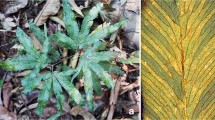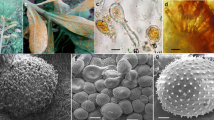Abstract
An unknown species of rust was observed on sugarcane in Swaziland and South Africa in 2008. Infected leaves showed rust-like symptoms on the abaxial and adaxial leaf surfaces. Uredinia appeared bright orange when fresh, releasing profuse, bright orange urediniospores, which distinguished it from Puccinia melanocephala, the only rust species known to infect sugarcane in southern Africa at that time. No identical matches were obtained from the NCBI database for the combined ITS and 28S nuclear large subunit (nLSU) regions for the unknown rust. Phylogenetic analyses based on the same gene region showed that this rust was closely related to Macruropyxis fraxini and Puccinia sparganioides, which infect Fraxinus spp. (Oleaceae). Also closely related were Aecidium klugkistianum, P. mysuruensis, and P. physalidis which infect host species in the Oleaceae, Rubiaceae, and Solanaceae, respectively. This group of rusts is phylogenetically distinct from both Puccinia melanocephala and Puccinia kuehnii, which cause brown and orange rust of sugarcane, respectively. Phylogenetic reconstruction showed that the unknown rust falls outside the Puccinia I and II clades and groups with the Macruropyxis clade with strong bootstrap support. Hence the name proposed for this newly discovered rust species is Macruropyxis fulva sp. nov., causal agent of tawny rust of sugarcane. A rust observed to be infecting Miscanthus ecklonii in 2016 matched the accessioned M. fulva sp. nov. sequences and was morphologically and genetically distinct from the Miscanthus rust Puccinia miscanthidii, providing evidence of an alternate host for M. fulva sp. nov.



Similar content being viewed by others
References
Aime MC (2006) Toward resolving family-level relationships in rust fungi (Uredinales). Mycoscience 47:112–122
Altschul SF, Gish W, Miller W, Myers EW, Lipman DJ (1990) Basic local alignment search tool. J Mol Biol 215:403–410
Bailey RA (1979) An assessment of the status of sugarcane diseases in South Africa. Proceedings of the South African Sugar Technologists Association, 120–128
Bailey RA (1995) Coping with disease problems. Proceedings of the South African Sugar Technologists Association, 215–216
Bankevich A, Nurk S, Antipov D, Gurevich AA, Dvorkin M, Kulikov AS, Lesin VM, Nikolenko SI, Pham S, Prjibelski AD, Pyshkin AV, Sirotkin AV, Vyahhi N, Tesler G, Alekseyev MA, Pevzner PA (2012) A new genome assembly algorithm and its applications to single-cell sequencing. J Comput Biol 19:455–477
Beenken L, Wood AR (2015) Puccorchidium and Sphenorchidium, two new genera of Pucciniales on Annonaceae related to Puccinia psidii and the genus Dasyspora. Mycol Prog 14:49
Beenken L, Zoller S, Berndt R (2012) Rust fungi on Annonaceae II: the genus Dasyspora Berk. & M.A. Curtis. Mycologia 104(3):659–681
Braithwaite KS, Croft BJ, Magarey RC, Scharaschkin T (2009) Phylogenetic placement of the sugarcane rust pathogen Puccinia kuehnii in a historical and regional context. Australas Plant Pathol 38:380–388
Camacho C, Coulouris G, Avagyan V, Ma N, Papadopoulos J, Bealer K, Madden TL (2009) BLAST+: architecture and applications. BMC Bioinf 10:421
Chevreux B, Wetter T, Suhai S (1999) Genome sequence assembly using trace signals and additional sequence information. In: Computer Science and Biology: Proceedings of the German Conference on Bioinformatics (GCB) 45–56
Chona BL, Munjal RL (1950) Puccinia kuehnii (Krueg.) Butler on sugarcane in India. Curr Sci 19:151–152
Comstock JC, Shine JM Jr, Raid RN (1992) Effect of rust on sugarcane growth and biomass. Plant Dis 76(2):175–177
Comstock JC, Sood SG, Glynn NC, Shine JM Jr, McKemy JM, Castlebury LA (2008) First report of Puccinia kuehnii, causal agent of orange rust of sugarcane, in the United States and western hemisphere. Plant Dis 92:175
Cummins GB, Hiratsuka Y (2003) Illustrated genera of rust fungi, Third edn. American Phytopathological Society, St. Paul
Dixon LJ, Castlebury LA, Aime MC, Glynn NC, Comstock JC (2010) Phylogenetic relationships of sugarcane rust fungi. Mycol Prog 9:459–468
Do CB, Mahabhashyam MS, Brudno M, Batzoglou S (2005) ProbCons: probabilistic consistency-based multiple sequence alignment. Genome Res 15(2):330–340
Doidge EM (1948) South African rust fungi. Bothalia 4(4):500–501. doi:10.4102/abc.v4i4.1737
Drummond AJ (2010) Geneious Pro version 5.6.7 created by Biomatters. Available from http://www.geneious.com/
Egan BT (1964) Rust. In: Hughes CG, Abbott EV, Wismer CA (eds) Sugar-cane diseases of the world, volume II. Elsevier, Amsterdam, Netherlands, pp. 61–68
Egan BT (1980) A review of the world distribution of Puccinia spp. attacking sugar cane. Proc Int Soc Sugar Cane Technol Assoc 17:1373–1381
Estep MC, McKain MR, Vela Diaz D, Zhong J, Hodge JG, Hodkinson TR, Layton DJ, Malcomber ST, Pasquet R, Kellogg EA (2014) Allopolyploidy, diversification, and the Miocene grassland expansion. Proc Natl Acad Sci U S A 111(42):15149–15154
Glynn NC, Dixon LJ, Castlebury LA, Szabo LJ, Comstock JC (2010) PCR assays for the sugarcane rust pathogens Puccinia kuehnii and P. melanocephala and detection of a SNP associated with geographical distribution in P. kuehnii. Plant Pathol 59:703–711
Huelsenbeck JP, Ronquist F (2001) MRBAYES: Bayesian inference of phylogeny. Bioinformatics 17:754–755
Katoh K, Standley DM (2013) MAFFT multiple sequence alignment soft-ware version 7: improvements in performance and usability. Mol Biol Evol 30:772–780
Katoh K, Misawa K, Kuma K, Miyata T (2002) MAFFT: a novel method for rapid multiple sequence alignment based on fast Fourier transform. Nucleic Acids Res 30(14):3059–3066
Lanfear R, Calcott B, Kainer D, Mayer C, Stamatakis A (2014) Selecting optimal partitioning schemes for phylogenomic datasets. BMC Evol Biol 14:82
Li H, Durbin R (2009) Fast and accurate short read alignment with burrows-wheeler transform. Bioinformatics 25(14):1754–1760
Lloyd Evans D, Joshi SV (2016) Elucidating modes of activation and herbicide resistance by sequence assembly and molecular modelling of the Acetolactate synthase complex in sugarcane. J Theor Biol 407:184–197
Löytynoja A, Goldman N (2005) An algorithm for progressive multiple alignment of sequences with insertions. Proc Natl Acad Sci U S A 102(30):10557–10562
Magarey RC, Croft BJ, Willcox TG (2001) An epidemic of orange rust on sugarcane in Australia. Proc Int Soc Sugar Cane Technol Assoc 24:410–416
McFarlane K, McFarlane SA, Moodley D, Rutherford RS (2006) Fungicide trials to determine the effect of brown rust on the yield of sugarcane variety N29. Proc S Afr Sugar Technol Assoc 80:297–300
McKenna A, Hanna M, Banks E, Sivachenko A, Cibulskis K, Kernytsky A, Garimella K, Altshuler D, Gabriel S, Daly M, DePristo MA (2010) The genome analysis toolkit: a MapReduce framework for analyzing next-generation DNA sequencing data. Genome Res 20(9):1297–1303
Minnis AM, McTaggart AR, Rossman AY, Aime MC (2012) Taxonomy of mayapple rust: the genus Allodus resurrected. Mycologia 104(4):942–950
Mirarab S, Nguyen N, Warnow T (2014) PASTA: ultra-large multiple sequence alignment. In: Sharan R (ed) Research in computational molecular biology. Springer International Publishing, Switzerland, pp. 177–191
Purdy LH, Krupa SV, Dean JL (1985) Introduction of sugarcane rust into the Americas and its spread to Florida. Plant Dis 69:689–693
Rambaut A, Suchard MA, Xie D, Drummond AJ (2014) Tracer v1.6, Available from http://beast.bio.ed.ac.uk/Tracer
Roy BA, Vogler DR, Bruns TD, Szaro TM (1998) Cryptic species in the Puccinia monoica Complex. Mycologia 90:846–853
Ryan CC, Egan BT (1989) Rust. In: Ricaud C, Egan BT, Gilaspie Jr AG, Hughes CG (eds) Diseases of sugarcane – major diseases. Elsevier, Amsterdam, The Netherlands, pp. 189–210
Saumtally AS, Viremouneix TR, Ahondokpê B, Girard J-CR, Castlebury LA, Dixon L, Glynn NC, Comstock JC (2011) First report of orange rust of sugarcane caused by Puccinia kuehnii in Ivory Coast and Cameroon. Plant Dis 95:357
Simmons MP, Ochoterena H (2000) Gaps as characters in sequence-based phylogenetic analyses. Syst Biol 49(2):369–381
Stamatakis A (2014) RAxML version 8: a tool for phylogenetic analysis and post-analysis of large phylogenies. Bioinformatics 30:1312–1313
Sukumaran J, Holder MT (2010) DendroPy: a python library for phylogenetic computing. Bioinformatics 26:1569–1571
Taylor PWJ, Croft BJ, Ryan CC (1986) Studies into the effect of sugarcane rust (Puccinia melanocephala) on yield. Proc Int Soc of Sugar Cane Technol Assoc 19:411–419
Tóth A, Hausknecht A, Krisai-Greilhuber I, Papp T, Vágvölgyi C, Nagy LG (2013) Iteratively refined guide trees help improving alignment and phylogenetic inference in the mushroom family Bolbitiaceae. PLoS One 8(2):e56143
Vilgalys R, Hester M (1990) Rapid genetic identification and mapping of enzymatically amplified ribosomal DNA from several Cryptococcus species. J Bacteriol 172:4238–4246
Virtudazo EV, Nakamura H, Kakishima M (2001) Phylogenetic analysis of sugarcane rusts based on sequences of ITS, 5.8 S rDNA and D1/D2 regions of LS rDNA. J Gen Plant Pathol 67:28–36
Walker BJ, Abeel T, Shea T, Priest M, Abouelliel A, Sakthikumar S, Christina A, Cuomo CA, Zeng Q, Wortman J, Young SK, Earl AM (2014) Pilon: an integrated tool for comprehensive microbial variant detection and genome assembly improvement. PLoS One 9(11):e112963
Wilgenbusch JC, Warren DL, Swofford DL (2004) AWTY: A system for graphical exploration of MCMC convergence in Bayesian phylogenetic inference. http://ceb.csit.fsu.edu/awty.
Acknowledgements
Research funding received from the South African sugar industry through SASRI is gratefully acknowledged. We would like to thank James M. Shine, Jr. and the Florida Sugar Cane League for funding L.A. Martin’s visit to the United States Department of Agriculture, Agricultural Research Service, Systematic Mycology and Microbiology Laboratory in Beltsville, Maryland, USA, as well as Dr. Amy Rossman for hosting the visit. Dr. Linley Dixon is acknowledged for confirming that this rust was distinct from other sugarcane rusts and Sasha Allen, Dr. Jill Demers and Tunesha Phipps for technical assistance in Beltsville, MD. The assistance of Nelisha Murugan (Microscopy and Microanalysis Unit, University of KwaZulu-Natal, South Africa) for SEM imaging is gratefully acknowledged. Thanks to the South African National Biodiversity Institute (SANBI) for identification of the unknown grass as Miscanthus ecklonii (Nees) Mabb.
Mention of trade names or commercial products in this publication is solely for the purpose of providing specific information and does not imply recommendation or endorsement by the United States Department of Agriculture. USDA is an equal opportunity provider and employer.
Author information
Authors and Affiliations
Corresponding author
Electronic supplementary material
ESM 1
(DOCX 105 kb)
Rights and permissions
About this article
Cite this article
Martin, L.A., Lloyd Evans, D., Castlebury, L.A. et al. Macruropyxis fulva sp. nov., a new rust (Pucciniales) infecting sugarcane in southern Africa. Australasian Plant Pathol. 46, 63–74 (2017). https://doi.org/10.1007/s13313-016-0460-1
Received:
Accepted:
Published:
Issue Date:
DOI: https://doi.org/10.1007/s13313-016-0460-1




